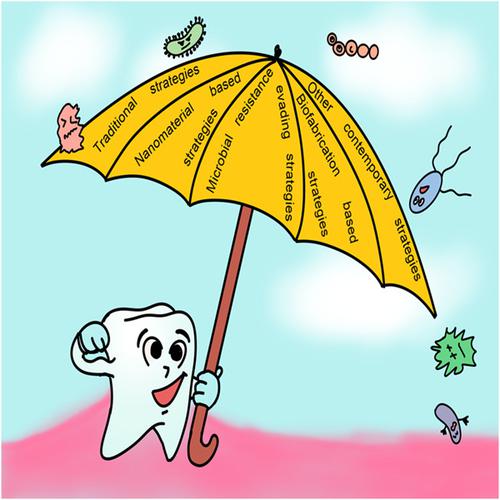当前位置:
X-MOL 学术
›
Biotechnol. Bioeng.
›
论文详情
Our official English website, www.x-mol.net, welcomes your feedback! (Note: you will need to create a separate account there.)
Strategies toward development of antimicrobial biomaterials for dental healthcare applications
Biotechnology and Bioengineering ( IF 3.8 ) Pub Date : 2021-10-02 , DOI: 10.1002/bit.27948 Shivangi Parhi 1, 2 , Sreyasi Pal 1 , Sujoy K Das 2, 3 , Paulomi Ghosh 1, 2
Biotechnology and Bioengineering ( IF 3.8 ) Pub Date : 2021-10-02 , DOI: 10.1002/bit.27948 Shivangi Parhi 1, 2 , Sreyasi Pal 1 , Sujoy K Das 2, 3 , Paulomi Ghosh 1, 2
Affiliation

|
Several approaches for elimination of oral pathogens are being explored at the present time since oral diseases remain prevalent affecting approximately 3.5 billion people worldwide. Need for antimicrobial biomaterials in dental healthcare include but is not restricted to designing resin composites and adhesives for prevention of dental caries. Constant efforts are also being made to develop antimicrobial strategies for clearance of endodontic space prior root canal treatment and for treatment of periimplantitis and periodontitis. This article discusses various conventional and nanotechnology-based strategies to achieve antimicrobial efficacy in dental biomaterials. Recent developments in the design and synthesis of antimicrobial peptides and antifouling zwitterionic polymers to effectively lessen the risks of antimicrobial drug resistance are also outlined in this review. Further, the role of contemporary strategies such as use of smart biomaterials, ionic solvent-based biomaterials and quorum quenchers incorporated biomaterials in the elimination of dental pathogens are described in detail. Lastly, we mentioned the approach of using polymers to print custom-made three-dimensional antibacterial dental products via additive manufacturing technologies. This review provides a critical perspective on the chemical, biomimetic, and engineering strategies intended for developing antimicrobial biomaterials that have the potential to substantially improve the dental health.
中文翻译:

用于牙科保健应用的抗菌生物材料的开发策略
目前正在探索几种消除口腔病原体的方法,因为口腔疾病仍然普遍影响着全世界约 35 亿人。牙科保健中对抗菌生物材料的需求包括但不限于设计用于预防龋齿的树脂复合材料和粘合剂。还在不断努力开发抗菌策略,用于在根管治疗前清除牙髓间隙以及治疗种植体周围炎和牙周炎。本文讨论了在牙科生物材料中实现抗菌功效的各种传统和基于纳米技术的策略。本综述还概述了抗菌肽和防污两性离子聚合物的设计和合成的最新进展,以有效降低抗菌药物耐药性的风险。此外,还详细描述了当代策略的作用,例如使用智能生物材料、离子溶剂基生物材料和结合生物材料的群体猝灭剂在消除牙科病原体中的作用。最后,我们提到了使用聚合物通过增材制造技术打印定制的三维抗菌牙科产品的方法。这篇综述为旨在开发具有显着改善牙齿健康潜力的抗菌生物材料的化学、仿生和工程策略提供了批判性视角。详细描述了当代策略的作用,例如使用智能生物材料、基于离子溶剂的生物材料和结合生物材料的群体猝灭剂在消除牙科病原体中的作用。最后,我们提到了使用聚合物通过增材制造技术打印定制的三维抗菌牙科产品的方法。这篇综述为旨在开发具有显着改善牙齿健康潜力的抗菌生物材料的化学、仿生和工程策略提供了批判性视角。详细描述了当代策略的作用,例如使用智能生物材料、基于离子溶剂的生物材料和结合生物材料的群体猝灭剂在消除牙科病原体中的作用。最后,我们提到了使用聚合物通过增材制造技术打印定制的三维抗菌牙科产品的方法。这篇综述为旨在开发具有显着改善牙齿健康潜力的抗菌生物材料的化学、仿生和工程策略提供了批判性视角。我们提到了使用聚合物通过增材制造技术打印定制的三维抗菌牙科产品的方法。这篇综述为旨在开发具有显着改善牙齿健康潜力的抗菌生物材料的化学、仿生和工程策略提供了批判性视角。我们提到了使用聚合物通过增材制造技术打印定制的三维抗菌牙科产品的方法。这篇综述为旨在开发具有显着改善牙齿健康潜力的抗菌生物材料的化学、仿生和工程策略提供了批判性视角。
更新日期:2021-11-10
中文翻译:

用于牙科保健应用的抗菌生物材料的开发策略
目前正在探索几种消除口腔病原体的方法,因为口腔疾病仍然普遍影响着全世界约 35 亿人。牙科保健中对抗菌生物材料的需求包括但不限于设计用于预防龋齿的树脂复合材料和粘合剂。还在不断努力开发抗菌策略,用于在根管治疗前清除牙髓间隙以及治疗种植体周围炎和牙周炎。本文讨论了在牙科生物材料中实现抗菌功效的各种传统和基于纳米技术的策略。本综述还概述了抗菌肽和防污两性离子聚合物的设计和合成的最新进展,以有效降低抗菌药物耐药性的风险。此外,还详细描述了当代策略的作用,例如使用智能生物材料、离子溶剂基生物材料和结合生物材料的群体猝灭剂在消除牙科病原体中的作用。最后,我们提到了使用聚合物通过增材制造技术打印定制的三维抗菌牙科产品的方法。这篇综述为旨在开发具有显着改善牙齿健康潜力的抗菌生物材料的化学、仿生和工程策略提供了批判性视角。详细描述了当代策略的作用,例如使用智能生物材料、基于离子溶剂的生物材料和结合生物材料的群体猝灭剂在消除牙科病原体中的作用。最后,我们提到了使用聚合物通过增材制造技术打印定制的三维抗菌牙科产品的方法。这篇综述为旨在开发具有显着改善牙齿健康潜力的抗菌生物材料的化学、仿生和工程策略提供了批判性视角。详细描述了当代策略的作用,例如使用智能生物材料、基于离子溶剂的生物材料和结合生物材料的群体猝灭剂在消除牙科病原体中的作用。最后,我们提到了使用聚合物通过增材制造技术打印定制的三维抗菌牙科产品的方法。这篇综述为旨在开发具有显着改善牙齿健康潜力的抗菌生物材料的化学、仿生和工程策略提供了批判性视角。我们提到了使用聚合物通过增材制造技术打印定制的三维抗菌牙科产品的方法。这篇综述为旨在开发具有显着改善牙齿健康潜力的抗菌生物材料的化学、仿生和工程策略提供了批判性视角。我们提到了使用聚合物通过增材制造技术打印定制的三维抗菌牙科产品的方法。这篇综述为旨在开发具有显着改善牙齿健康潜力的抗菌生物材料的化学、仿生和工程策略提供了批判性视角。



























 京公网安备 11010802027423号
京公网安备 11010802027423号